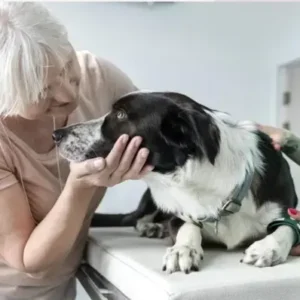Causes of Elbow Dysplasia in Dogs
Several factors can contribute to elbow dysplasia in dogs:
- Genetic Factors: Certain dog breeds, huge breeds like labrador retrievers and German Shepherds, are more likely to develop canine elbow dysplasia due to genetic predisposition.
- Rapid Growth in Puppies: Puppies, huge breeds, are prone to abnormal bone growth during rapid development. This can lead to problems such as the ununited anconeal process (UAP) or fragmented medial coronoid process (FCP), which disrupt the normal function of the elbow joint.
- Environmental Factors and Obesity: Overfeeding and excessive weight gain can place undue stress on the growing joints, increasing the risk of elbow dysplasia. Maintaining a healthy weight is critical in preventing joint issues, especially for growing puppies under months of age.
Signs and Symptoms of Elbow Dysplasia
Elbow dysplasia in dogs can show up in several ways. Dogs with elbow dysplasia may also develop hip dysplasia, as both conditions share similar causes.
Recognizing the symptoms early can help prevent further damage:
- Lameness and Limping: A dog with elbow dysplasia may limp, particularly after exercise. The pain usually stems from the front leg, where the elbow joint is located.
- Difficulty Moving or Playing: Dogs may avoid running, jumping, or engaging in physical activity due to discomfort in the elbow joint.
- Swelling in the Elbow Area: Swelling around the elbow joint, particularly where the medial humeral condyle and other bones meet, can indicate inflammation.
- Pain and Stiffness: Pain and limited range of motion in the elbow are common signs, and your dog may show discomfort when the joint is touched.
Diagnosis of Elbow Dysplasia
If you suspect your dog has elbow dysplasia, take them to a veterinarian for a thorough examination. The vet will begin by performing a physical exam and may recommend imaging tests, such as a CT scan or X-rays, to assess the condition of the elbow joint.
A CT scan can be particularly helpful in diagnosing issues like the Ununited Anconeal Process (UAP) or Fragmented Medial Coronoid Process (FCP). These tests allow the vet to visualize abnormal bone growth and determine the severity of the condition.
Treatment Options for Elbow Dysplasia
Treatment for elbow dysplasia in dogs varies depending on the severity of the condition.
Options include:
- Conservative Management: For mild cases, the vet may recommend a combination of medication, rest, and weight management. Physical therapy can also help to increase the range of motion and improve joint function.
- Surgical Treatments: In severe cases, surgery may be necessary. Procedures like ulnar osteotomy can help realign the bones and relieve pressure on the joint. For extreme cases, joint replacement surgery may be recommended.
- Physical Therapy and Rehabilitation: After surgery, physical therapy is crucial to help your dog regain strength and mobility in the affected joint. Post-surgical care and rehabilitation help improve the long-term outcome of surgery.
Preventing Elbow Dysplasia in Dogs
While elbow dysplasia is often genetic, there are several ways to reduce the risk or manage the condition:
- Proper Nutrition and Weight Management: Keeping your dog at a healthy weight can prevent excessive strain on the developing joints. Puppies, particularly large breeds, should be fed a balanced diet to support slow, healthy growth.
- Regular Exercise: Controlled, moderate exercise helps strengthen the muscles around the elbow joint, preventing excessive stress. Be cautious not to over-exercise puppies under months of age.
- Breeding Practices: Ethical breeding practices, such as screening for elbow dysplasia through the Orthopedic Foundation for Animals, can reduce the likelihood of passing on genetic predispositions to this condition.
Breeds Prone to Elbow Dysplasia
In addition to the commonly known breeds, several other larger dog breeds are also more likely to develop elbow dysplasia due to their size, growth patterns, and genetic factors.
These breeds include:
- Rottweiler
- Boxer
- Tibetan Mastiff
- Alaskan Malamute
- Doberman Pinscher
- Great Dane
- Weimaraner
- Belgian Malinois
- Chesapeake Bay Retriever
- Irish Wolfhound
- Labrador Retriever
- German Shepherd
- Golden Retriever
- Bernese Mountain Dog
- Saint Bernard
- Newfoundland
Prognosis and Quality of Life
The long-term prognosis for dogs with elbow dysplasia largely depends on the severity of the condition and the effectiveness of the treatment. Early diagnosis and intervention can help manage pain and improve mobility.
Dogs that undergo successful treatment, including surgical procedures like ulnar osteotomy, can often regain good long-term function and continue to enjoy an active life. However, some dogs may experience ongoing pain and reduced mobility, especially if the condition is not diagnosed early.








